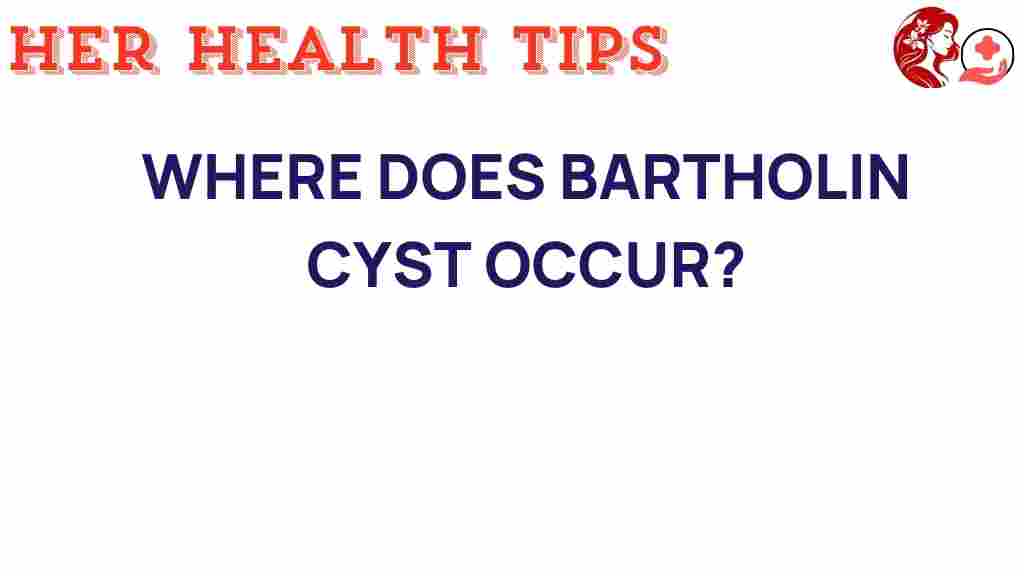Unveiling the Hidden Truth: Where Do Bartholin Cysts Occur?
When it comes to women’s health, understanding various gynecological conditions is crucial. One such condition that affects many women is the Bartholin cyst. These cysts can be a source of confusion and concern, often leading to questions about their causes, symptoms, and treatment options. In this article, we will delve deep into the world of Bartholin cysts, exploring their locations, implications for women’s health, and what steps can be taken for treatment and prevention.
What is a Bartholin Cyst?
A Bartholin cyst is a fluid-filled sac that forms when the Bartholin glands, located at the vaginal opening, become blocked. These glands are responsible for producing lubrication during sexual activity. When the ducts of these glands become obstructed, fluid accumulates, leading to the formation of a cyst. While Bartholin cysts can be asymptomatic, some women may experience discomfort, swelling, or pain.
Where Do Bartholin Cysts Occur?
Bartholin cysts specifically occur in the area of the Bartholin glands. To understand where these cysts develop, it is essential to know the anatomy of the female reproductive system:
- Location of Bartholin Glands: The Bartholin glands are located bilaterally at the 4 o’clock and 8 o’clock positions of the vaginal opening.
- Common Symptoms: While many women may not notice their cysts, symptoms can occur if the cysts become large or infected.
Symptoms of Bartholin Cysts
Symptoms associated with Bartholin cysts can vary widely. Some women may experience no symptoms at all, while others may report significant discomfort. Common symptoms include:
- Swelling or lump at the vaginal opening
- Pain during intercourse
- Painful urination
- Discomfort while sitting
- Redness and tenderness in the area
If a cyst becomes infected, symptoms may escalate to include:
- Fever
- Increased pain and swelling
- Drainage of pus from the cyst
Treatment Options for Bartholin Cysts
Treatment for Bartholin cysts depends on the severity of the symptoms and whether the cyst is infected. Here are some common treatment options:
1. Observation
If the cyst is small and asymptomatic, no immediate treatment may be necessary. Regular monitoring is often sufficient.
2. Warm Compresses
Applying warm compresses to the affected area can help alleviate discomfort and promote drainage if the cyst is blocked.
3. Drainage Procedures
If the cyst is large or painful, a healthcare provider may perform a drainage procedure:
- Incision and Drainage: The cyst can be surgically opened to allow the fluid to escape.
- Word Catheter: A small catheter may be inserted into the cyst to help keep it open and allow continuous drainage.
4. Antibiotics
If an infection is present, antibiotics may be prescribed to treat the underlying infection.
5. Marsupialization
For recurrent cysts, a procedure called marsupialization can be performed. This involves creating a permanent opening in the cyst wall to facilitate drainage and prevent future blockages.
Medical Insights into Bartholin Cysts
Understanding the medical background of Bartholin cysts is vital for women’s health. Here are some insights:
- Common in Women: Bartholin cysts are more prevalent in women aged 20 to 30.
- Potential Causes: Causes include infection, trauma, or inflammation in the area.
- Associated Conditions: They may be linked to other gynecological conditions such as sexually transmitted infections (STIs).
Prevention of Bartholin Cysts
While not all Bartholin cysts can be prevented, certain measures can reduce the risk:
- Safe Sex Practices: Using condoms can help reduce the risk of STIs.
- Regular Gynecological Check-ups: Routine visits to a healthcare provider can help monitor women’s health and detect issues early.
- Hygiene Practices: Maintaining good genital hygiene can help prevent infections.
Troubleshooting Tips for Managing Bartholin Cysts
If you suspect you have a Bartholin cyst or are experiencing symptoms, consider the following troubleshooting tips:
- Monitor Symptoms: Keep track of any changes in size or symptoms.
- Consult a Healthcare Provider: If symptoms worsen or do not improve, seek medical advice.
- Home Remedies: Use warm compresses to ease discomfort as a first step before seeking medical help.
Conclusion
In conclusion, Bartholin cysts are a common gynecological condition that can occur in the area of the Bartholin glands. While they often present no symptoms, awareness of their presence, symptoms, and treatment options is essential for maintaining women’s health. Understanding where Bartholin cysts occur, their implications, and how to manage and prevent them can empower women to take control of their health.
If you want to learn more about gynecological conditions and women’s health, check out this comprehensive guide. For medical insights and updates, visit the World Health Organization.
This article is in the category Conditions and created by HerHealthTips Team
